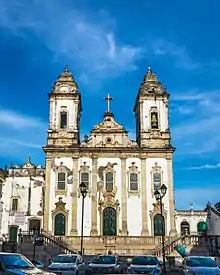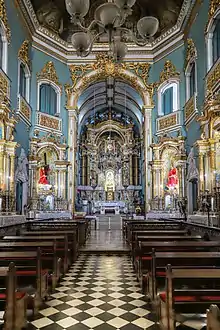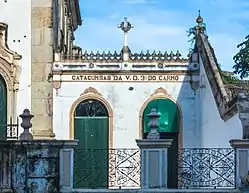Church of the Third Order of Mount Carmel
The Church of the Third Order of Mount Carmel (Portuguese: Igreja da Ordem Terceira do Carmo, also known as the Igreja da Ordem Terceira do Monte do Carmo) is an 18th-century Roman Catholic church in Salvador, Bahia, Brazil. It is located adjacent to the Church and Convent of Our Lady of Mount Carmel (Igreja e Convento de Nossa Senhora do Carmo). The Church of the Third Order of Mount Carmel was listed as a historic structure by National Institute of Historic and Artistic Heritage (IPHAN) in 1938 and is part of the Historic Center of Salvador UNESCO World Heritage Site.[1][2][3]
| Church of the Third Order of Mount Carmel | |
|---|---|
Igreja da Ordem Terceira do Carmo | |
 Facade of the Church of the Third Order of Mount Carmel | |
| Religion | |
| Affiliation | Catholic |
| Rite | Roman |
| Location | |
| Municipality | Salvador |
| State | Bahia |
| Country | Brazil |
 Location of the Church of the Third Order of Mount Carmel in Brazil | |
| Geographic coordinates | 12.969201°S 38.507507°W |
| Architecture | |
| Style | Baroque |
| Completed | 1855 |
National Historic Heritage of Brazil | |
| Designated | 1938 |
| Reference no. | 82 |
History
The Third Order of Mount Carmel was founded in Portugal in 1629, following the establishment of the Carmelites in Portugal in 1251. The Third Order of Mount Carmel in Salvador was established in 1636 in Bahia by Pedro Alves Botelho, a wholesale trader; Pedro da Silva, the governor of Bahia and Count of São Lourenço, was its first prior. Construction of the first church structure began in 1644 with permission from the Convent of Our Lady of Mount Carmel; the land was donated by residents of Salvador. The brotherhood was recognized by a papal bull on December 12, 1695 under the name of "Venerável Ordem Terceira da Mãe Santíssima e Soberana Senhora do Monte do Carmo", or the Venerable Third Order of the Holy Mother and Sovereign Lady of Monte do Carmo. The master woodcarver Lourenço Rodrigues Lançarote completed extensive work on the church between 1733 and 1734; he later carved the ornate side altars of the Basilica of the Immaculate Conception, Salvador.[4][5][2]
The church was destroyed by fire on the night of March 21, 1788. The building was completely destroyed, but numerous images and other artwork were saved or salvaged from the building. The Order began reconstruction of the church in 1788, the same year of the fire, but was delayed by a lack of funds. Work began on the current structure in 1803; its facade in lioz from Portugal was completed in 1855. The interior of the church was richly decorated. It was completed later in the century.[1][5][2][3]
Structure


The Church of the Third Order of Mount Carmel sits at the top of Ladeira do Carmo, a street leading north from the main squares of the Pelourinho. It is in close proximity to the Church of the Blessed Sacrament at Rua do Passo. The structure, of brick and stone masonry, is slightly set back from street level and is approached via a large staircase in stone. The structure is built around two courtyards. Its plan is vast in scale and consists of the church and sacristy, an ossuary, a consistory room (casa da mesa), and a house of saints (casa dos santos). The galleries are glazed.[3]
Exterior
The exterior of the church features a staircase, two towers with a frontispiece and pilasters, doorways of lioz stone. The style of the facade is eclectic; it has both Neoclassical elements of the period and Roccoco elements common to other churches in the Pelourinho. The facade is crowned by a cross and a relief of the coat of arms of the Carmelites. The decorative elements of the towers were considered old-fashioned at the time.[1]
Interior
The floor plan of Church of the Third Order of Mount Carmel is typical of eighteenth-century Bahian religious architecture. It has a single nave, side altars, side aisles with tribunes, a chancel, and a sacristy. The sacristy provides access to the ossuary in the lower level. The interior of the church is in the Neoclassical style, common to both church architecture in Salvador and across Brazil in the 18th century. The nave has an organ imported from France. The principal work of the church is cedar carving of Christ inlaid with rubies; the rubies represent 2,000 drops of blood. It is the work of Francisco Xavier Chagas and dates to 1730. The ceiling of the nave features figurative paintings by José Teófilo de Jesus and were executed between 1815 and 1817. The statue of Our Lady of Mount Carmel on the altar is said to be a likeness of Isabel II, daughter of Garcia d'Ávila.[5][3][6]
Notable artwork
- Apresentação do Menino Jesus no Templo (panel painting in the sacristy), ca. 1730, José Pinhão de Matos.
- Nossa Senhora do Carmo entregando o escapulário a Santa Teresa D'Ávila e a São João da Cruz (nave ceiling), ca. 1817, José Teófilo de Jesus
- Senhor Assentado na Pedra, attributed to Francisco das Chagas
- Senhor com a Cruz às Costas, attributed to Francisco das Chagas
- Senhor Crucificado, attributed to Francisco das Chagas[6]
Protected status
The Church of the Third Order of Mount Carmel was listed as a historic structure by the National Institute of Historic and Artistic Heritage in 1938. It is listed in the Book of Historical Works process no. 82.[1][3]
Access
The church is open to the public and may be visited.
References
- Carrazzoni, Maria, ed. (1980). Guia dos bens tombados (in Portuguese). Rio de Janeiro, RJ: EXPED-Expansão Editorial. p. 65. ISBN 9788520800577.
- Lins, Eugénio Ávila (2012). "Church of the Third Order of Mount Carmel". Lisbon, Portugal: Heritage of Portuguese Influence/Património de Influência Portuguesa. Retrieved 2017-03-29.
- "Igreja e Casa da Ordem Terceira do Carmo (Salvador, BA)" (in Portuguese). Brasília, Brazil: IPHAN. 2017. Retrieved 2017-04-04.
- Freire, Luiz Alberto Ribeiro; Hernandez, Maria Hermínia Olivera, eds. (2014). "Lourenço Rodrigues Lançarote". Dicionário Manuel Querino de arte na Bahia. Salvador, Bahia: Escola de Belas Artes, Universidade Federal da Bahia. Retrieved 2020-01-07.
- Pequena guia das igrejas da Bahia. Salvador, Bahia: Prefeitura da Cidade do Salvador. 1977. pp. 16–23.
- "Francisco das Chagas". ENCICLOPÉDIA Itaú Cultural de Arte e Cultura Brasileiras. São Paulo: Itaú Cultural. 2015. Retrieved 2018-12-04.
| Wikimedia Commons has media related to Igreja da Ordem Terceira do Carmo, Salvador, Bahia. |
